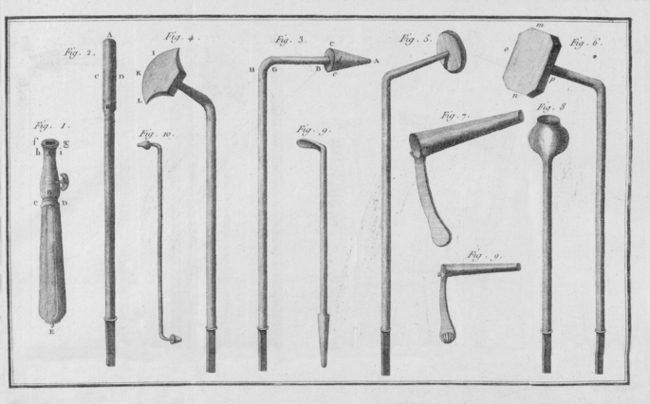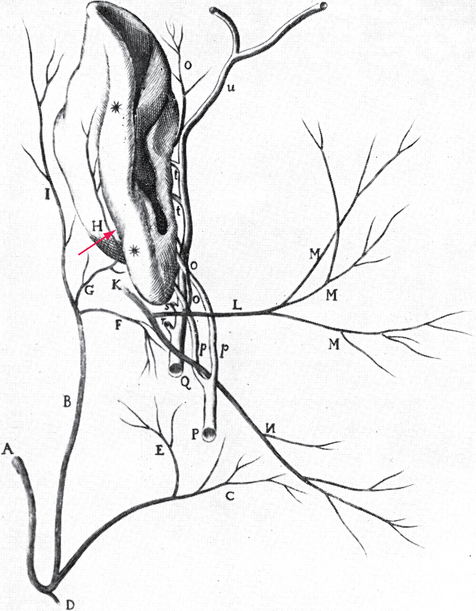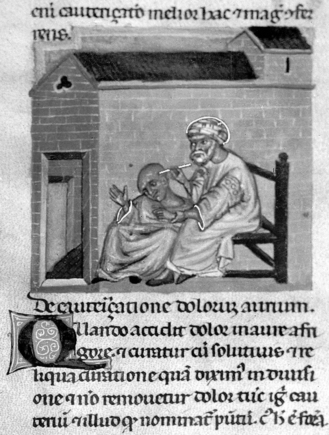Chapter 1 The history of the method
INTRODUCTION
The great surgeons Avicenna (980–1037) and Abū al-Qāsim, also known as Albucasis (d. c.1013), were particularly skilled in cauterization, and in selecting the appropriate instruments and techniques. Albucasis stated in the first book of his work,1 dedicated entirely to cauterization: ‘the cautery excels the drug by the rapidity of its success, the strength of its action, and the potency of its powers’. However, he admonished his pupils:
He removed some prejudices which still existed in this period:
In Albucasis’s time many parts of the body and several diseases were treated with cauterization, for example pleurisy, chest complaints, liver abscesses, diseases of the spleen, dropsy, piles and anal fistula, painful menstruation and infertility, toothache, migraine, sciatic pain, etc. In Chapter 5 of his book Albucasis described the following treatment for earache:
Albucasis at work is depicted in a series of miniatures accompanying the Latin translation of his text (Fig. 1.1).
The method of cauterization spread throughout Europe, and many physicians applied the actual cautery until well into the 19th century. In France, the country in which the practice of cauterization had most support and was most widespread, it was used in the hospitals of all the principal towns, and the person who in 1811 best summarized the history of the actual cautery and best described the technique was a Frenchman, Pierre-François Percy (1754–1825), a surgeon at the court of Napoleon, who had had considerable experience on the battlefield. Percy2 ordered at least 10 instruments of different dimensions and shapes to be forged for various uses. The heated instruments were inserted into a special wooden handle (Fig. 1.2).

Fig. 1.2 Percy’s ten cauteries with handle on the left.
(Reproduced with the permission of the Wellcome Institute for the History of Medicine, London.)
The instruments were classified into three groups:
In England the practice of ironing the painful part with a laundress’s iron (the skin being protected by being covered with a piece of thin flannel or brown paper) had long been in vogue for various types of pain. However, it was only after 1830 that physicians such as Henry William Fuller3 and James Syme4 proposed the use of the actual cautery for lumbago, stiff neck and other forms of ‘muscular rheumatism’, which at that time included sciatica.
An exceptional case report comes from one of the great surgeons of the history of medicine, Joseph Lister. Having qualified in London, Lister went to Scotland, where in 1854 he became Syme’s house-surgeon at the Edinburgh hospital. During his stay he probably witnessed patients being treated with the actual cautery, as in the following case:5
Case IV. – Disease between the Atlas and Axis:
Actual Cautery applied with great benefit.
At this time he was, according to his own account, about as bad as he had been at all. His countenance wore a peculiar expression of mingled suffering and apprehension, as Mr. Syme expressed it. He complained of severe pain in the neck and head, aggravated by any sudden movement, so that there was a great constraint about all his actions. He always kept his head bolt upright except when in bed, and could neither lie down nor get up without supporting his head with his hands; he never turned his head without the rest of the body, but gentle nodding was not very painful. There was great swelling of the upper part of the neck, and he could only open his mouth a little way; deglutition was extremely difficult, and a remarkable prominence of the bodies of the upper cervical vertebrae was to be felt in the pharynx.
CAUTERIZATION OF THE EAR
Among the more reliable pieces of information on cauterization of the ear in ancient literature, the quotations from the work of Johannes Scultetus or Schultheiss (1595–1645) reported in Percy’s book2 are remarkable. The physician was the pupil of the famous anatomist Adrian van der Spieghel of Brussels (1578–1625), also known as Spigel. The pupil observed the teacher cauterizing the antitragus of patients with toothache on the same side as the pain. This was a technique which he had applied also on himself: ‘hac nova chirurgia dolor non amplius revertitur…ejusque virtutem in se primum expertus est auctor; post modum, me praesente, in non paucis aliis’ (‘with this new surgery the pain does not relapse so intensely…the value of which the author appreciated first on himself; afterwards, in my presence, also on not a small number of other patients’).
Another excellent witness, not so many decades later, was the anatomist Antonio Valsalva (1666–1723), who performed the first rigorous and documented differentiation between outer, middle and inner ear. In his book,6 based, according to his biographers, on 16 years of tireless work dissecting more than 1000 human skulls, particular mention is made of cauterizations carried out by healers on the posterior part of the lobe with the aim of treating toothache. Valsalva wrote:
Figure 1.3 shows the location of the site which was most frequently cauterized.

Fig. 1.3 The site (arrow) of cauterization for toothache according to Valsalva.6 ‘H = Locus, ubi ramus cujus ustio à quibusdam practicis ad tollendam odontalgiam proponitur, certius uretur’ (‘H = The site where the branch was more certainly burned by some healers for treating toothache’).
< div class='tao-gold-member'>
Stay updated, free articles. Join our Telegram channel

Full access? Get Clinical Tree









